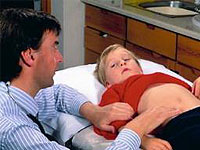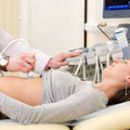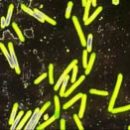Complications of appendicitis in children arise as a result of the spread of inflammation to a significant part of the peritone. Features of the flow of appendicitis in children and postoperative condition caused by the result of gangrene or perforations of a worm-like process - the topic of the article today.
Content
 Complications of acute appendicitis are formidable diseases that are commonly developing when the inflammatory process is distributed from an obstructed worm-like procession to the surrounding fabrics, peritoneum, subcutaneous fat tissue and vessels.
Complications of acute appendicitis are formidable diseases that are commonly developing when the inflammatory process is distributed from an obstructed worm-like procession to the surrounding fabrics, peritoneum, subcutaneous fat tissue and vessels.
Peritonitis — The most frequent and severe complication of appendicitis in children, one of the main causes of tragic fatal outcome. Inflammation may be limited to a small plot of peritoneum, then it — Limited or local peritonitis. One of his options is an appendicular infiltrate that develops on the 3-4th day of the disease with the appearance of painful, dense and fixed education in the ileum region, marked with a symptom of the brush-blubberb, an increase in temperature to 37-38 0C and moderate leukocytosis.
If inflammation spreads to several abdominal regions, this is the case of a total or spilled peritonitis, which is a deadly complication. Manifests itself a significant increase in abdominal pain, increasing body temperature, leukocytosis increase. There is a sharp deterioration in the overall state of the baby, an increase in the size of infiltration, the strengthening of the symptoms of peritonean irritation, which requires urgent surgical intervention.
Rather dangerous and serious complication — The inflammation of the portal vein or pylephlebit has a heavy septic flow and manifests itself to a rapidly increasing fever, an increase in liver, tachycardia and hypotension. The formidable consequence of appendectomy are also intestinal obstruction and formation of thromboms.
In addition, the inflammation of the appendix is fraught with local complications — These are hematomas, ligature fistula and the suppuration of postoperative seams.
On the peculiarities of the flow of appendicitis in children
 Acute inflammation of the draft-like proof begins with its inner shell, then applies to all layers, causing a phlegmonous or gangrenous process, which is accompanied by the destruction of appendix and the exit of pus into the abdominal cavity. Complete running process leads to the development of peritonitis. From the duration of the disease depends on its complexity and development of stages: the catarrhal process lasts the first 6 hours from the beginning of inflammation, phlegmonous — within 24 hours and gangrenous — With disease duration up to 3 days.
Acute inflammation of the draft-like proof begins with its inner shell, then applies to all layers, causing a phlegmonous or gangrenous process, which is accompanied by the destruction of appendix and the exit of pus into the abdominal cavity. Complete running process leads to the development of peritonitis. From the duration of the disease depends on its complexity and development of stages: the catarrhal process lasts the first 6 hours from the beginning of inflammation, phlegmonous — within 24 hours and gangrenous — With disease duration up to 3 days.
The clinical picture of acute appendicitis in children is represented by pain in the abdomen of permanent character, nausea, vomiting, increase in temperature to 38c and above, pulse, and intestinal disorders. The abdominal pain at the beginning of the process is spilled in nature and only a few hours later, the child is able to approximately specify its localization, most often it is the right lower square, it is there that the blind intestine is located there is a response to the question: «How to define appendicitis?» The child, as well as an adult in this case, is peculiar to multiple vomiting, anxiety, lack of sleep, liquid stool with mucus, pain in the right iliac region. Parents at this time should pay attention to one peculiarity: the child lies, curled up by the eagle, almost does not turn, the abdomen is noted, the retention of gases and stool. Face features during an attack sharpen, on the face — Fear, baby scared, looking for protection and sympathy in mom. Mom's big mistake, if at this time she, trying to help the chad, resorts to the means of traditional medicine, washed «Voraor stomach» With the help of the enema, or, wanting to facilitate the suffering of the child, gives him something painkiller. This should not be done in any way, it erases a real picture of the patient's state, it is necessary to contact a specialist — children's surgeon, only the doctor will answer the question «How to determine the child's appendicitis?»
If the state of the baby worsens, immediately call the brigade «Ambulance», And before the doctor's arrival, you must lay a child, to provide him with full peace and attach cold to the abdomen. The diagnosis of appendicitis consists in palpation of the abdominal muscles, which will indicate an experienced doctor on a positive symptom of Brush-Blumyberg. To confirm the diagnosis in a hospital, all necessary laboratory surveys will be performed, including urine and blood tests, as well as ultrasound of appendix and abdominal organs.









